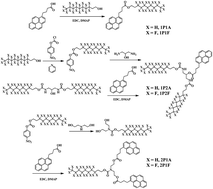How side-chain substituents and substrates influence mechanochromic luminescence: case study with pyrene†
Abstract
Many organic molecules exhibit reversible, force-induced emission change known as mechanochromic luminescence (ML) and can potentially be used as mechanosensors. Here we provide an example on how ML behaviours can be modulated by side-chain substituents which serve as the directing group, as well as substrates which may disrupt the function of the directing group.



 Please wait while we load your content...
Please wait while we load your content...